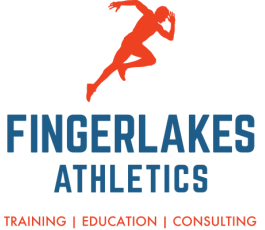|
One of the best ways to improve sports performance is to get faster. Speed is a coveted athletic ability that coaches actively recruit for. We used to think that speed ability was genetically determined, but now know that speed is a skill that can be learned, taught and developed.
Before we talk about how to become faster, it is important to differentiate sport speed from track speed. Speed in a sport setting does not bear the same resemblance to track speed where every run follows the same predictable sets of events. Sport speed is adaptable where each run may be different, so when we talk about improving speed for sport, we are really discussing learning and reinforcing skills that will transfer to on field performance. We also need to remember that sport speed is not just linear, but will involve different lateral movement, change of direction, acceleration and deceleration events that all need to be considered and trained. The development of speed in a track setting will follow different rules since this form of speed is all linear and very repeatable. For our improvement of sport speed we can break down speed into its smaller components and focus on each component before bringing everything back together to create a newer, faster athlete. The chain of events for speed development (in a linear sense) are reaction time, acceleration, maximum speed and speed maintenance or speed endurance. To improve reaction time we have our athletes perform pursuit drills, ball drops and speed initiation on verbal cues. To improve acceleration we focus on falling starts, wall drills to learn the proper form of forward lean from the ankles, different starts like a split stance, false step or straight step from a stationary position and then work into flying starts and transitions. We also utilize resisted and assisted techniques to improve acceleration such as sled pulls, parachutes, uphill runs, downhill runs and bands. In the weight room athletes focus on improving their explosive power which will translate on the field as greater force to the ground leading to faster acceleration. Plyometric exercises, Olympic lifts and explosive strength exercises like squats and lunges all help develop power. For many team sports, athletes may never get out of the reaction time and acceleration phases before having to make some type of change, either in direction or speed. So, working with athletes to get as fast as possible in 20 yards may form the majority of training. If athletes do routinely get beyond 20 yards then developing their max speed comes into play. The best way to accomplish raw speed is to spend more time sprinting. This develops the nervous system and the musculoskeletal systems to work at peak levels and is a great way to improve speed. To augment their speed training, have athletes perform strength workouts with the goal of gaining strength and power. Once again, plyometrics, Olympic lifts and heavy strength exercises will all help increase speed. This increase in strength, coupled with practicing being faster will result in increased athletic speed. Speed endurance or speed maintenance is the ability to maintain maximum speed over longer distances. This is especially important in track events where the ability to maintain speed can lead to victory, but for field sports, this is the ability to maintain speed on breakaway plays. By training athletes to sprint over longer distances we improve their speed capacity. Increasing the length of sprints and tracking time will demonstrate how effectively athletes are maintaining their speed. Developing each of these components will lead to faster athletes, but there are other considerations to think about. Working with athletes to optimize their form will decrease inefficiencies and improve sprinting quality. Not every athlete will be able to achieve the 'ideal' running form, but they can all improve their form to be the best they can be in their own body. So, improving form along with strength can lead to faster athletes. Another consideration for field athletes is recovery. Many sports are sprint-recover type sports where they need to be able to react, accelerate, hit top speed quickly and then change pace before doing it again. Having athletes perform sprint repeats while fatigued will help aid their conditioning, but will not help out with hitting max speed since they will be fatigued and max speed training requires that athletes are fully rested. Other sports have different needs and may need to develop transition speed or change of direction speed. Stealing a base in baseball is an example where athletes start with lateral movement before explosively changing direction into linear movement. This is also teachable. Observing the movements in the sport will offer insight into the types of movements and transitions that are being utilized. While not a definitive guide to speed, the main thing to remember is to develop global strength and power, work on running form and training fast. Athletes that train fast get fast. Good luck!
0 Comments
Leave a Reply. |
AuthorI write on sport management, fitness, sports medicine and business topics to help you reach your goals Archives
February 2024
Categories
All
|
|
Home
About Contact |
To learn more about what services we offer, to schedule an appointment or to get prices please contact me at
[email protected] (607)279-6791 *This site is for educational purposes only, it is not meant to diagnose, treat or replace medical advice. Before starting an exercise program always make sure that you are healthy and able to do so safely.* |


 RSS Feed
RSS Feed